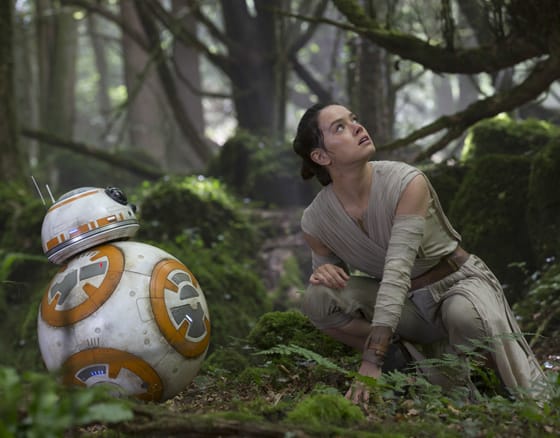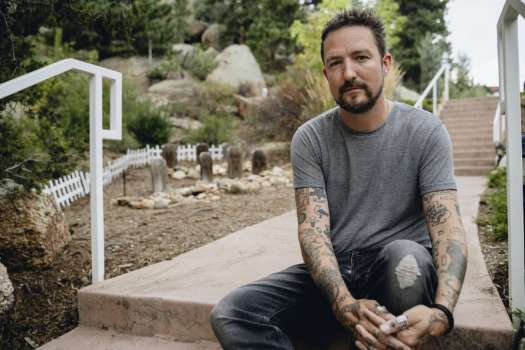Star Wars is no longer a movie franchise — it's a corporate juggernaut aimed at colonizing not just young minds, but those (like mine) whose youth is interwoven with George Lucas's mythology, whose very sense of cinema has been shaped (for good and ill) first by his myth-making and then by ongoing digital tinkering that for many has tarnished his legacy.
Having lived through Star Wars before it was called A New Hope, and survived the initial onslaught of hype that greeted Lucas's taxation-and-representation-themed digital paintings that the prequels turned out to be, nothing compares to the fervour that now surrounds The Force Awakens. No less than the future of the property has been placed in the franchise-capable hands of J.J. Abrams (who's now overseeing Star Trek and Mission: Impossible as well as producing features based on Portal and Half-Life). And he's done so by going back to his — and the movie's — roots.
Gone are the MS Paint worlds devoid of dust and sweat that marked Lucas's prequels; The Force Awakens feels immediately real, tactile and lived in. And while most fans are banking on The Force Awakens giving them a new hope in the future of Star Wars, Abrams is literally giving us A New Hope: The Force Awakens, in plot, character and feel, very much harkening back to the first chapter, the one we know as number four.
We meet Finn (Attack the Block's John Boyega), a Storm Trooper unwilling to go along with the fascistic mentality of that fighting force under the command of the First Order (a spiritual sequel to the Sith and the Empire that precede it). He escapes with pilot Poe Dameron (Oscar Isaac, Inside Llewyn Davis), a resistance fighter who's hidden some crucial information from the First Order in a small droid called BB-8. The trio crash on the desolate desert planet Jakku, where Finn encounters Rey (Daisy Ridley), who makes a living selling scrap metal she collects from the detritus of previous galactic warfare. (The desert is littered with the remains of a Star Destroyer as well as an AT-AT; nerdy shout-outs, both obvious and subtle, are scattered throughout.)
When powerful members of the First Order, including its black-masked, Force-enabled leader Kylo Ren, arrive on Jakku, Rey and Finn need to get BB-8 off planet and in the hands of the resistance; they steal a garbage ship long designated for scrap in an effort to get away. You'll never guess what famed saucer-shaped Kessel runner that turns out to be.
From there, the plot (such as I'm able to reveal) bears remarkable similarity to A New Hope, as our band of First Order-fighting rebels need to use the BB-8 stored intel in order to bring down the Starkiller Base — the First Order's new, upgraded, planet-destroying version of the Death Star. And while initially, tales of the Jedi, Darth Vader and the Empire have fallen into the realm of myth, or for some, fairy tale, some old friends — in the form of Han Solo (Harrison Ford), Chewbacca (Peter Mayhew) and now General Leia Organa (Carrie Fisher) — confirm that those old tales have some truth to them.
The trickiest balance is between faithful and innovative, and that's where Abrams — who co-wrote the screenplay with Michael Arndt and Lawrence Kasdan (screenwriter of The Empire Strikes Back and Return of the Jedi) — succeeds. He's intimately familiar with the desires of the fan base (and includes himself amongst us) but recognizes that mere fan service will be death to this franchise. The screenplay peppers in a bunch of familiar dialogue — some iconic, some just an echo for those who've memorized every word — and while the worlds feel familiar (deserts like Tatooine, forests like Endor, even some snow in a climactic light saber battle), the approach still feels fresh.
Part of that is in some smart choices of casting its archetypes. By casting a black actor (Boyega) and a woman (Ridley) as leads, Abrams knows that he's forever changing the ways in which the Star Wars mythos can be enjoyed, which for many children is in post-movie play. It was so when Star Wars first dropped in 1977, and it will be so when all the branded phone company calling cards and promotional energy drinks have moved on to the next DC juggernaut. By both honouring his love of the franchise, and shepherding a version that builds a solid foundation for new generations and new fans, Abrams has indeed given us a new hope.
(Disney)Having lived through Star Wars before it was called A New Hope, and survived the initial onslaught of hype that greeted Lucas's taxation-and-representation-themed digital paintings that the prequels turned out to be, nothing compares to the fervour that now surrounds The Force Awakens. No less than the future of the property has been placed in the franchise-capable hands of J.J. Abrams (who's now overseeing Star Trek and Mission: Impossible as well as producing features based on Portal and Half-Life). And he's done so by going back to his — and the movie's — roots.
Gone are the MS Paint worlds devoid of dust and sweat that marked Lucas's prequels; The Force Awakens feels immediately real, tactile and lived in. And while most fans are banking on The Force Awakens giving them a new hope in the future of Star Wars, Abrams is literally giving us A New Hope: The Force Awakens, in plot, character and feel, very much harkening back to the first chapter, the one we know as number four.
We meet Finn (Attack the Block's John Boyega), a Storm Trooper unwilling to go along with the fascistic mentality of that fighting force under the command of the First Order (a spiritual sequel to the Sith and the Empire that precede it). He escapes with pilot Poe Dameron (Oscar Isaac, Inside Llewyn Davis), a resistance fighter who's hidden some crucial information from the First Order in a small droid called BB-8. The trio crash on the desolate desert planet Jakku, where Finn encounters Rey (Daisy Ridley), who makes a living selling scrap metal she collects from the detritus of previous galactic warfare. (The desert is littered with the remains of a Star Destroyer as well as an AT-AT; nerdy shout-outs, both obvious and subtle, are scattered throughout.)
When powerful members of the First Order, including its black-masked, Force-enabled leader Kylo Ren, arrive on Jakku, Rey and Finn need to get BB-8 off planet and in the hands of the resistance; they steal a garbage ship long designated for scrap in an effort to get away. You'll never guess what famed saucer-shaped Kessel runner that turns out to be.
From there, the plot (such as I'm able to reveal) bears remarkable similarity to A New Hope, as our band of First Order-fighting rebels need to use the BB-8 stored intel in order to bring down the Starkiller Base — the First Order's new, upgraded, planet-destroying version of the Death Star. And while initially, tales of the Jedi, Darth Vader and the Empire have fallen into the realm of myth, or for some, fairy tale, some old friends — in the form of Han Solo (Harrison Ford), Chewbacca (Peter Mayhew) and now General Leia Organa (Carrie Fisher) — confirm that those old tales have some truth to them.
The trickiest balance is between faithful and innovative, and that's where Abrams — who co-wrote the screenplay with Michael Arndt and Lawrence Kasdan (screenwriter of The Empire Strikes Back and Return of the Jedi) — succeeds. He's intimately familiar with the desires of the fan base (and includes himself amongst us) but recognizes that mere fan service will be death to this franchise. The screenplay peppers in a bunch of familiar dialogue — some iconic, some just an echo for those who've memorized every word — and while the worlds feel familiar (deserts like Tatooine, forests like Endor, even some snow in a climactic light saber battle), the approach still feels fresh.
Part of that is in some smart choices of casting its archetypes. By casting a black actor (Boyega) and a woman (Ridley) as leads, Abrams knows that he's forever changing the ways in which the Star Wars mythos can be enjoyed, which for many children is in post-movie play. It was so when Star Wars first dropped in 1977, and it will be so when all the branded phone company calling cards and promotional energy drinks have moved on to the next DC juggernaut. By both honouring his love of the franchise, and shepherding a version that builds a solid foundation for new generations and new fans, Abrams has indeed given us a new hope.




